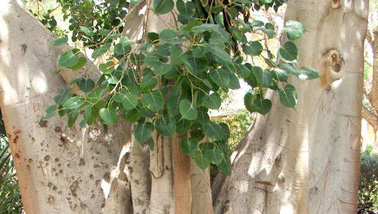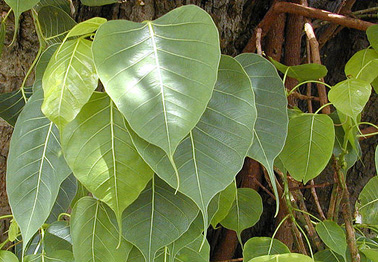|
Botanical Name:
Ficus religiosa
Asvattha consists of dried bark of Ficus religiosa Linn.,
Family Moraceae.
Common Name(s) in English & Indian Languages
Sanskrit: Pippala
Assamese: Ahant
Bengali: Asvattha, Ashud, Ashvattha
English: Pipal tree
Guajarati: Piplo, Jari, Piparo, Pipalo
Hindi: Pipala, Pipal
Kannada: Arlo, Ranji, Basri, Ashvatthanara, Ashwatha,
Aralimara, Aralegida,
Kashmiri: Bad
Malayalam: Arayal
Marathi: Pipal, Pimpal, Pippal
Oriya: Aswatha
Punjabi: Pipal, Pippal
Tamil: Ashwarthan, Arasamaram, Arasan, Arasu, Arara
Telugu: Ravichettu
Botanical description:
It is a large deciduous tree with few or no aerial roots. It
is often epiphytic with the drooping branches bearing long
petioled, ovate, cordate shiny leaves. Leaves are bright
green, the apex produced into a linear-lanceolate tail about
half as long as the main portion of the blade. The
receptacles occurring in pairs and are axillary, depressed
globose, smooth and purplish when ripe. The bark is grey or
ash coloured with thin or membranous flakes and is often
covered with crustose lichen patches. The outer bark is not
of uniform thickness, the middle bark in sections appear as
brownish or light reddish brown. The inner part consists of
layers of light yellowish or orange brown granular tissue.
Parts used:
Dried bark
Major chemical constituents:
Tannins
Therapeutic uses:
• Urinary disorders (Prameha)
• Bleeding disorder (Raktapitta)
• Ulcer (Vrana)
• Gout (Vatarakta)
• Disorder of female genital tract (Yonidosa) |
|


|
|
|



